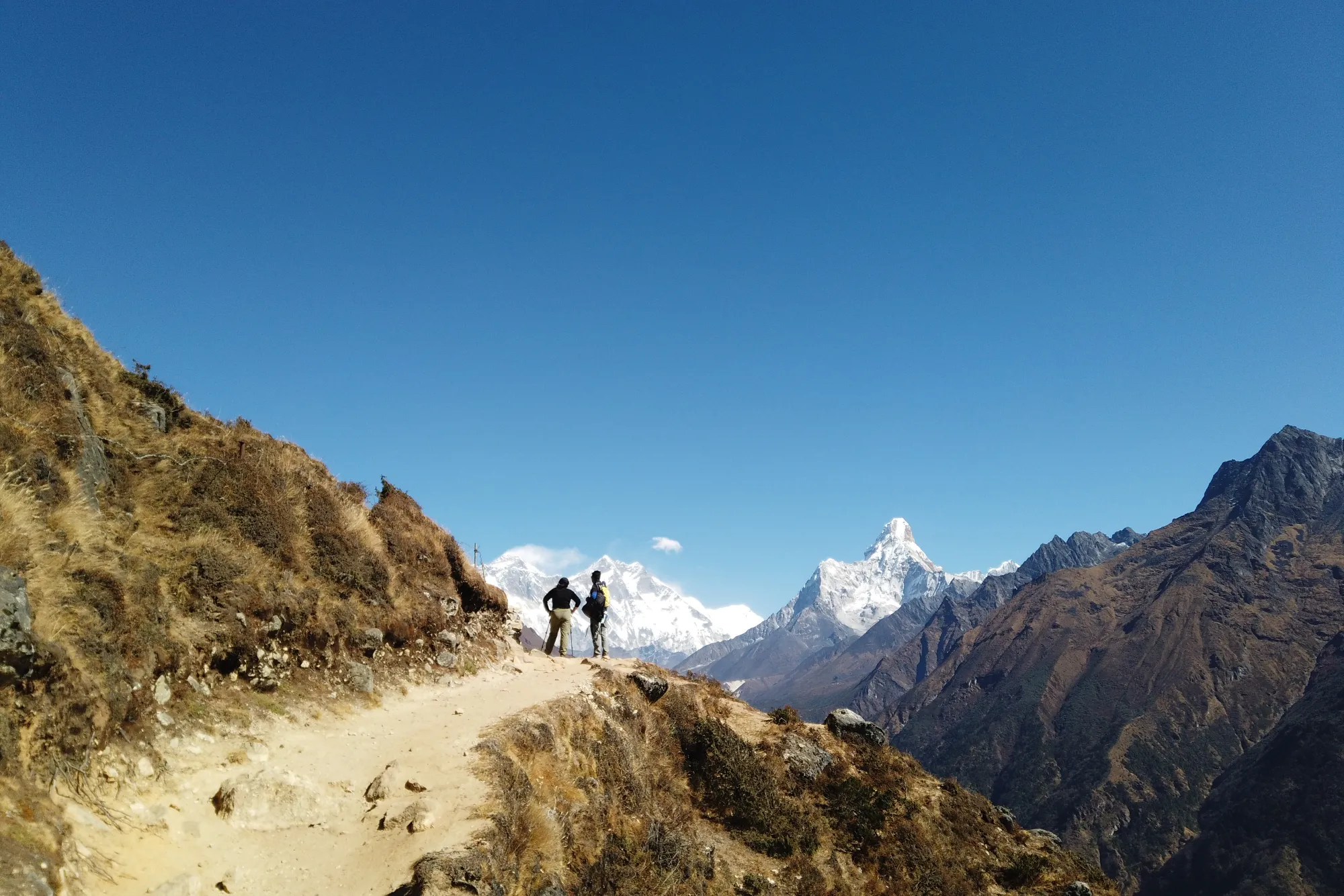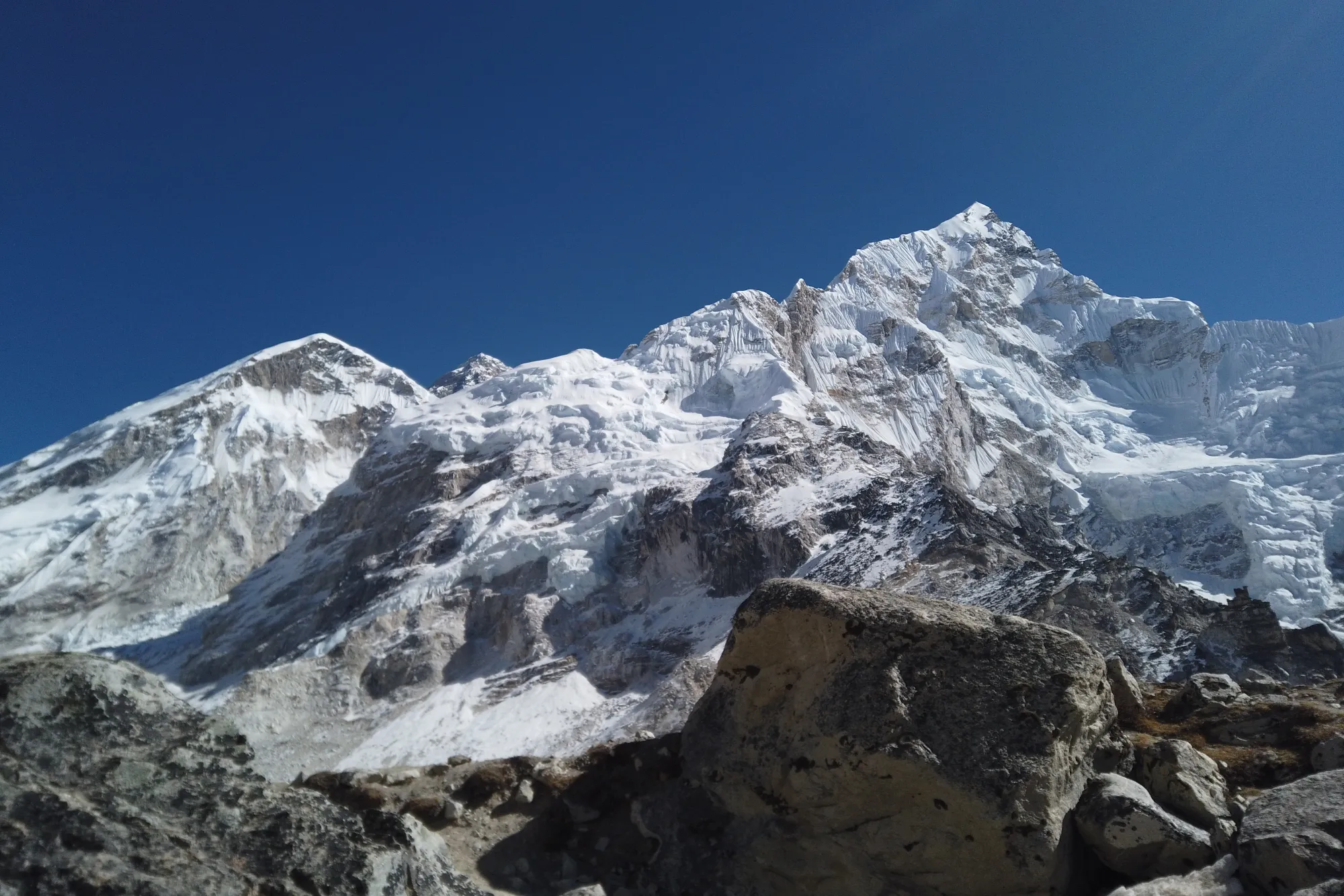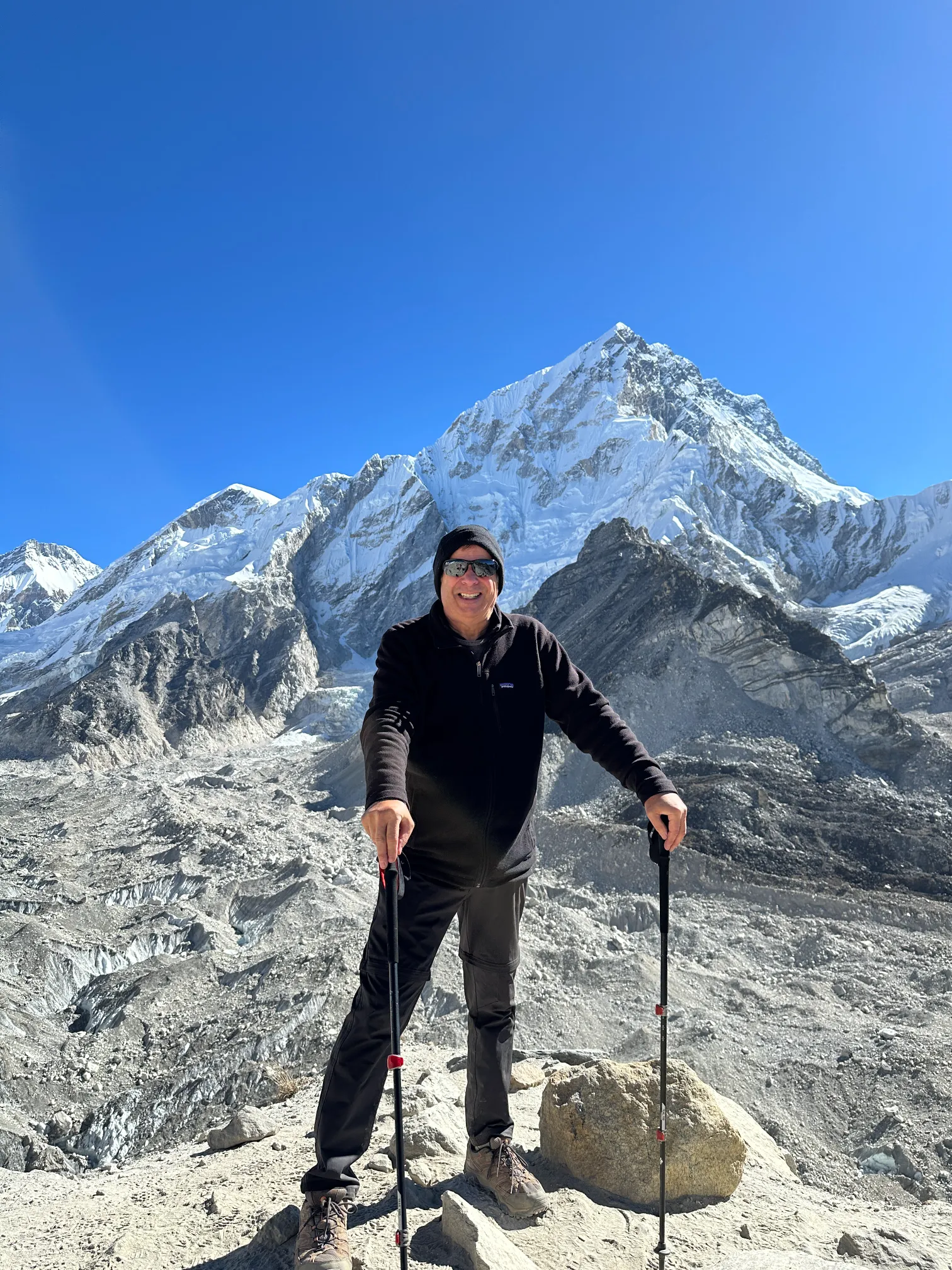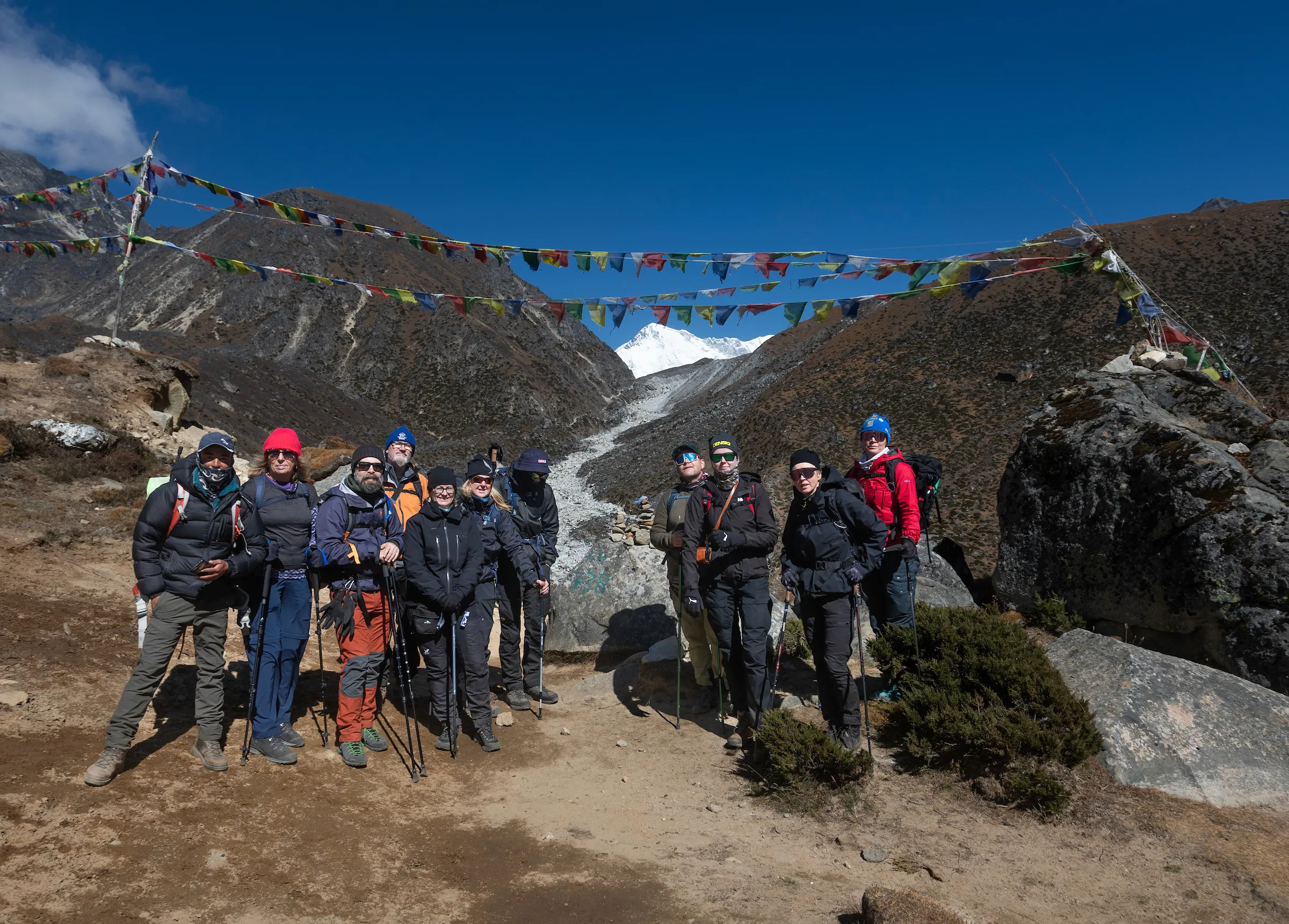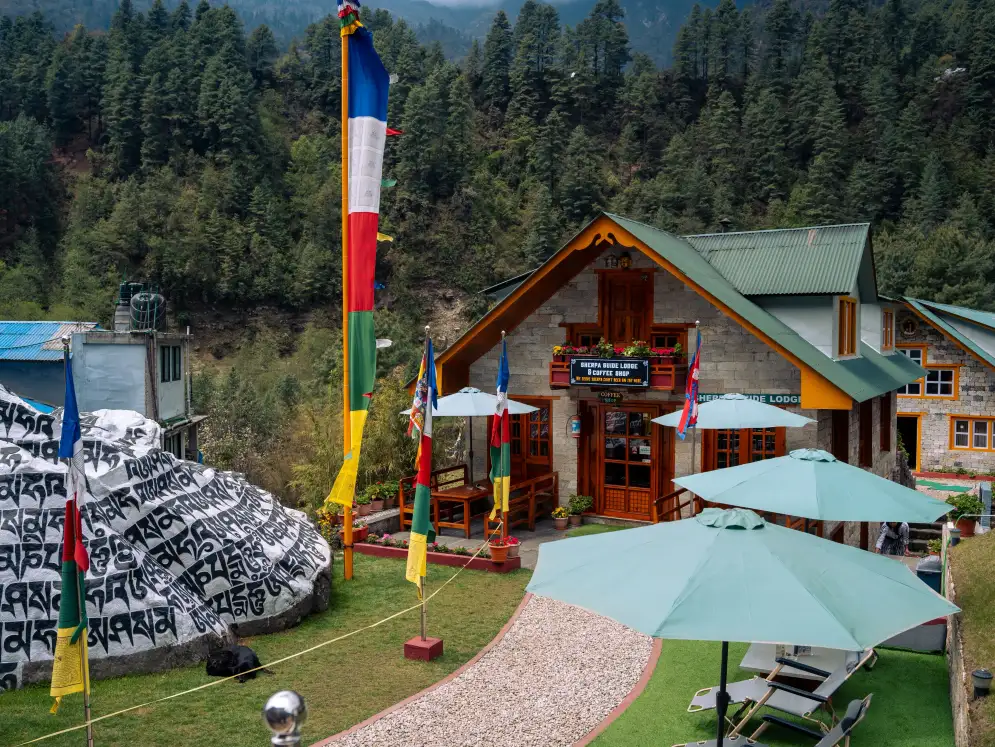Everest Base Camp Trek - 14 Days
Trip Duration
14 days
Nature Of Trip
Trekking
Maximum Altitude
(5,550m/18,208ft) Kalapatthar
Difficulty Grade
Hard
Start Point & End Point
Kathmandu
Kathmandu
Best Seasons
Mar to May & Sept to Dec
Meals
Breakfast in Kathmandu and all meals during the trek
Transportation
Private vehicle/Flight
Accommodation
Deluxe accommodation in Kathmandu and best upgraded teahouses during the trek
The Everest Base Camp trek is the classic trail encircling the majestic Everest. The trail offers a wonderful experience of the world's highest peak and the local Sherpa community, which has lived there for centuries.
Many trekkers have dreamt of leaving footprints on the world's tallest peak. That being said, the Everest Base Camp trek is the gateway to fulfilling this dream, offering the chance to create a lifetime of memories.
Trek to the World's Wonder, Everest Base Camp Trail
Everest Base Camp Trek starts with a scenic drive from Kathmandu to the town of Ramechhap. Afterwards, you take a short flight to the little mountain town of Lukla. Lukla is where everything starts. It is the main access point to visit the Khumbu region, where you can take a day off to unwind and experience the first half of the region's mountainous beauty.
Now, get ready to walk through the steep ascent and muddy trails of the lush forest beside Dudh Koshi and cross the Hillary Suspension bridge. Spin the prayer wheel and enjoy the local children playing games and women carrying a doko full of grass for the wildlife in their homes.
After the beautiful natural charm and immersive cultural experience, the trail takes you to Phakding. There are numerous teahouses with happy faces and basic amenities that offer a place to rest.
The cold breeze, warm smiles of majestic Ama Dablam, and the sound of the Yak Bells are part of the trail that leads you to Everest Base Camp. The trail winds through Sagarmatha National Park, a UNESCO World Heritage Site. The place is home to a diverse range of flora and fauna, making it a welcoming habitat for endangered species.
The first highlight of the trail is the little hamlet town of Namche Bazar. This ancient town, with a touch of modern beauty, nestled in the arms of the Everest region, has a lot to offer. Wander in the lively market, visit the Sherpa museum, and enjoy breakfast with a bird 's-eye view of Everest—one of the best things to do in Namche. Aside from that, explore different cafes and try out the local and international food in the chilly climate of Namche.
As you walk the well-maintained trail, leaving behind the densely populated Sherpa community along the spinning prayer wheel, flying chorten, and the walls beautifully encrypted by Om Mane Pemba Om.
Moreover, the monasteries along the trail, such as Tengboche and Pangboche, are other places to escape unwanted thoughts, immerse yourself in a peaceful environment, and listen to the chanting of the Lamas.
After moving through the physical challenge of uneven land surface, crossing glaciers reaching above 4000m, and high mountains surrounded by peaks reaching 6000m to 8000m above. The final climax and highlight of the trial is Kalapathar, where you can lose yourself in the golden rays striking the majestic Everest and showcasing its snow beauty at sunrise and sunset. The views will take you out of this world.
Throughout the whole trekking trail, the white cheering smile and charm of Mt. Everest (8,848.86m), Mt. Lhotse (8,516m), Mt. Makalu (8,485m), Mt. Cho Oyu (8,188m), Mt. Nuptse (7,855m), Mt. Pumori (7,165m), Mt. Ama Dablam (6,812m), and Mt. Thamserku (6,623m) are one of a kind.
Everest Base Camp Trek - 14 Days Route

Itinerary Outline:
1st Day: Arrival day in Kathmandu (1,300m/4,264 ft)
2nd Day: Fly to Lukla (2,840m/9,138ft) & trek to Phakding (2,610m/8,562ft) 3-4 hrs walk
3rd Day: Trek from Phakding to Namche Bazaar (3,440m/11,286ft) 5-6 hrs walk
4th Day: Acclimatization day at Namche Bazaar
5th Day: Hike from Namche to Tyangboche (3,860m/12,664ft) 5-6 hrs walk
6th Day: Trek to Dingboche (4,410m/14,469 ft) 5-6 hrs walk
7th Day: Acclimatization day at Dingboche
8th Day: Trek Dingboche to Lobuche (4,940m/16,207ft) 5-6 hrs walk
9th Day: Trek to Gorakshep (5,164m/16,942ft) & hike to Everest Base Camp (5,364m/17,598ft) 5-6 hrs walk
10th Day: Early Hike to Kala Patthar(5,550m/18,208ft) & trek back to Pheriche 6-7 hrs walk
11th Day: Trek back from Pheriche to Namche (3,440m/11,286ft) 6-7 hrs walk
12th Day: Trek Namche to Lukla (2,840m/9,138ft) 6-7 hrs walk
13th Day: Fly back to Kathmandu
14th Day: Departure from Kathmandu
End of our Services
Day In the Lap Of Everest Base Camp Trek Trail
The early morning as you wake up to the cold breeze coming straight from the world's highest Himalayan range and views of the majestic peaks right from the room. Immersing in the beauty for a while now, you freshen up and enjoy the hearty meal. Then begins walking through the steep ascent, the lush forest on the well-maintained trail. Remember, do not rush; carry on at a slow pace.
The highlight of the day is walking through appealing scenery and flapping chorten, immersing in the natural charm and Buddhist culture of the region.
As you burn off some calories now, the body needs some energy provided by the savory lunch at the teahouses. Finally, you wrap up the day after the long hour of walking, you have a night stay at the local tea houses. The night ends with a warm and light dinner and fun interaction with fellow trekkers. The local tea houses provide the basic amenities and rooms with private bathrooms.
Everest Base Camp Trek - 14 Days Altitude Chart

Detailed Itinerary
Day 01: Arrival day in Kathmandu (1,300m/4,264 ft)
Car
20 Minutes
Overnight
Kathmandu
Meal
Welcome Dinner
Accommodation
Hotel
Our representative will be waiting for you in the Tribhuwan International Airport to welcome and help you to make the transfer to your hotel in Kathmandu. You will get some refreshment time which will be then followed by the welcome dinner in one of the traditional Nepalese restaurants in the center of Kathmandu. You will be given short details about the trip and then again taken back to the hotel for an overnight stay.
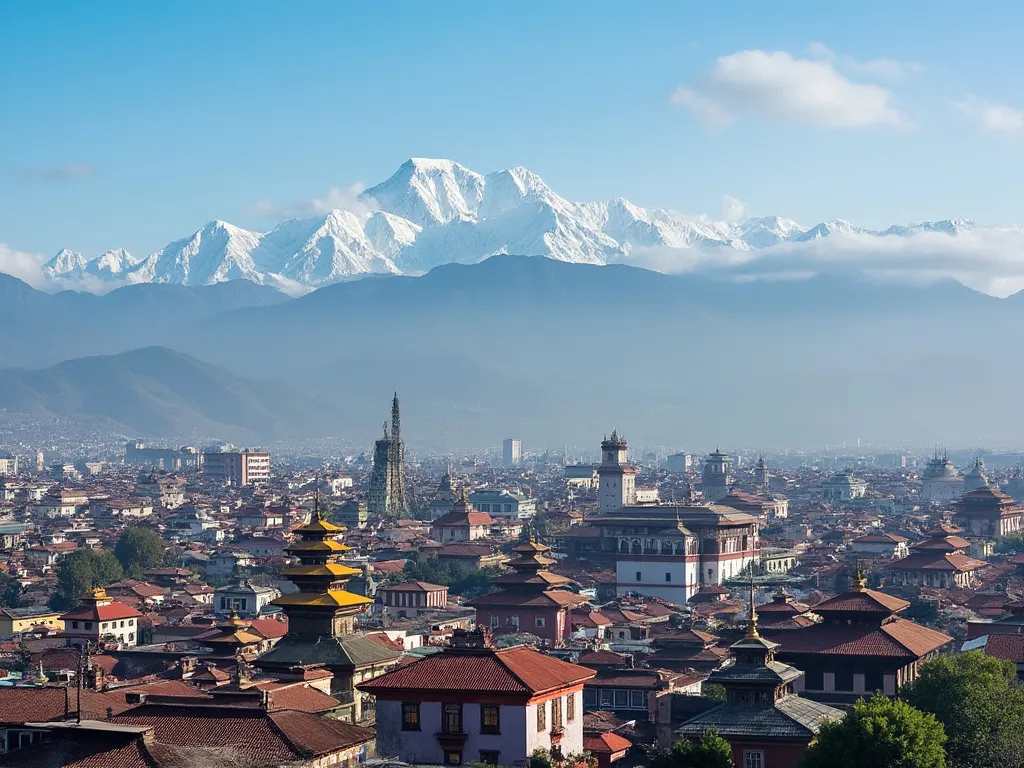
Day 02: Fly to Lukla (2,840m/9,318ft) & trek to Phakding (2,610m/8,562ft) 3-4 hrs walk
Car
20 Minutes
Overnight
Phakding
Meal
3 Meals
Flight
27 Minutes
Walking
3-4 Hrs
Accommodation
Tea House
Early in the morning, we will take a picturesque flight of around 40 minutes from Kathmandu to the deadliest airport at Lukla (if weather conditions and other local factors don't result in cancellations and delays). After arriving at Lukla, we will meet the Sherpa team. You will have time to explore the city while the guide divides and sorts a load of luggage into sections that will be carried by porters. We will take a short walk to the northwest of the village of Phakding, where we will spend the night. You can spend the remaining time exploring the community to learn more about it.

Day 03: Phakding to Namche Bazaar (3,440m/11,286ft) 5-6 hrs walk
Overnight
Namche
Meal
3 Meals
Walking
5-6 Hrs
Accommodation
Tea House
We will start our hike through the western banks of Dudh Koshi after an early breakfast. Continuing the trek, we arrive at a settlement in Monjo after we cross two of the tiny suspension bridges. A little after a few more hours of the trek lead us to Jorsalle, which is the only town before Namche Bazaar. Namche Bazaar is the capital thriving trading center of the Khumbu Region. Overnight.

Day 04: Acclimatization day at Namche Bazaar & Explore
Overnight
Namche
Meal
3 Meals
Accommodation
Tea House
As we are trekking a higher elevation, we will need a certain time to adjust to the increasing elevation, hence, we will take an acclimatization day in Namche Bazaar (3,440m/11,283ft). Namche Bazaar is a beautiful location that is worthwhile exploring the neighborhood. In this place, you can buy anything from toothpicks to ice axes. Many people can shop in the Saturday market to fulfill their daily needs as there is only one retail market in the nearby areas. You can utilize your time with a short visit to the Everest View Point Hotel which offers an amazing panoramic view. You may also go back to your hotel for the night after visiting the Sherpa Museum, a terrific place to learn about Sherpa culture and mountaineering history.

Day 05: Namche to Tyangboche (3,860m/12,664ft) 5-6 hrs walk
Overnight
Tyangboche
Meal
3 Meals
Walking
5-6 Hrs
Accommodation
Tea House
Early on the fifth day of the trek, we will leave the hamlet and travel up a high-level path above the Dudh Koshi, taking in breathtaking mountains along the way, including Mount Everest, Nuptse, Lhotse, Thamserku, and Kwangde. The route will then descends through a blue pine forest before we return to Phunki Thanga to bridge the Dudh Kosi (3,250m). We will ascend once more on a switchback trail that is occasionally made quite dusty by yak trains to reach the Thyangboche Monastery, a place that must be visited once in a lifetime. You can meet up with the monks and know about its history when it was destroyed by fire in 1989. Overnight.

Day 06: Tyangboche to Dingboche (4,410m/14,469 ft) 5-6 hrs walk
Overnight
Dingboche
Meal
3 Meals
Walking
5-6 Hrs
Accommodation
Tea House
We will get up early and then pace up the trails that take us through the rhododendron forests and meadows to the Buddhist nunnery at Deboche before we arrive at the Imja Khola. The traverses that lead to the Makalu region and the Hinko Valley through the Sherpani Col (6,100m) are the most challenging ones on our expedition. The Island Peak and Amphu Laptsa Peak both pass through Dingboche, Chukung Col, and further still. Overnight.

Day 07: Acclimatization day at Dingboche & Explore
Overnight
Dingboche
Meal
3 Meals
Accommodation
Tea House
You'll take the day off to relax before taking some extreme adventures the following day. The trek to Chhukung (4,730m), which takes about 3-4 hours from Dingboche, towards the east within the Imjatse Valley, is worthwhile if you don't want a gradual rest day. Although the trek is gradual, you can feel the thin air as the altitude gains gradually coming towards Chhukung. You may choose to take a full day off if not then there are some places where you can go for a day's walk. There aren't many teahouses in Chhukung, but those that do provide wonderful views of the glaciers and snow-covered peaks. Following a pleasant stroll, We return to Dingboche for the night.

Day 08: Dingboche to Lobuche (4,940m/16,207 ft) 5-6 hrs walks
Overnight
Labuche
Meal
3 Meals
Walking
5-6 Hrs
Accommodation
Tea House
Our journey on this day will take you to the Dughla village, over a hill where there are several memorials to Sherpas who lost their lives on Everest trips. Enjoying views of Kalar Pattar and Pumori, continuing along the Khumbu Glacier Moraine, we will travel through the difficult road to Lobuche. Overnight.

Day 09: Trek to Gorakshep (5,164m/16,942ft) & hike to Everest Base Camp Trek 14 days(5,364m/17,598ft) 5-6 hrs walk
Overnight
Gorakshep
Meal
3 Meals
Walking
5-6 Hrs
Accommodation
Tea House
Our hike will start with a small incline at the beginning that quickly turns into a steeper ascent that lasts for about 30 minutes. Then, a descent back down will lead us to Gorak Shep, where we will be checking into our lodge, passing over the windy and rocky trail with an amazing view of Mt. Pumori, Mt. Nuptse, and other magnificent peaks. After lunch, we continue on our trip to the Khumbu Icefall and Everest Base Camp. The trail crosses through the stony dunes, moraines, and streams and continues till we reach the base camp. During the peak expedition season, most of the climbers congregate at the Everest Base Camp Trek in preparation for summiting Everest. In the base camp, we will tour the base camp and the glacier that will surround it before making our way back to Gorakshep for the night.

Day 10: Early Hike to Kala Patthar(5,550m/18,208ft) & trek back to Pheriche 6-7 hrs walk
Overnight
Pheriche
Meal
3 Meals
Walking
6-7 Hrs
Accommodation
Tea House
On this day, you will be climbing to the highest elevation on the trek. Your guide will be scheduling time to climb Kala Patthar(5,550m), the place that offers the most breathtaking Everest dawn views. You can get to this famous viewpoint after two hours of walking. The place will offer the greatest views of Mount Everest, Nuptse, Pumori, Ama Dablam, and the entire Khumbu Himalayan range. After admiring this magnificent sight, we will descend to Gorak Shep, have breakfast, and then turn around and travel back toward Pheriche for the night.

Day 11: Pheriche to Namche(3,440m/11,286ft) 6-7 hrs walks
Overnight
Namche
Meal
3 Meals
Walking
6-7 Hrs
Accommodation
Tea House
As we make our way to Pangboche, the trail will get primarily downhill. The highest year-round village in the upper Khumbu Valley is Pangboche. The Pangboche monastery, the oldest monastery in the area, is open for visits when we get here. You will bring wonderful memories with you as you descend the slope toward Phungithanka via Tangboche, then continue trekking to Kyanjuma, the intersection of the three routes leading to Gokyo Valley, Khumjung Village, and Namche Bazaar. The rhododendron forest contains a great view of Ama Dablam, Thamserku, Tawache, and Lhotse as well as a variety of fauna, including Himalayan Griffons, Musk deer, and wild goats. In the evening, you may tour a nearby area and take in the breathtaking environment. Stay the night at Namche.

Day 12: Namche to Lukla (2,840m/9,318ft) 6-7 hrs walks
Overnight
Lukla
Meal
3 Meals
Walking
6-7 Hrs
Accommodation
Tea House
After breakfast, you can walk at your leisure through the lush green surroundings, going past the amazing mountain vistas, and local Sherpa hamlet down to the Hilary suspension bridge, Lukla. Upon arrival in Lukla, your guide will confirm the details of your airline ticket, and you'll have time to explore the neighborhood before spending the night at a hotel.

Day 13: Fly back to Kathmandu
Car
20 Minutes
Overnight
Kathmandu
Meal
Breakfast & Farewell Dinner
Flight
27 Minutes
Accommodation
Hotel
If the weather allowed, we take an early morning flight to Kathmandu. Our guide will transport you to your accommodation. When a lengthy journey to the Himalayas ends, you may have time to unwind, catch your breath, and recover at your hotel. We will be gathering that evening for the last goodbye meal.

Day 14: Departure from Kathmandu
Car
20 Minutes
Meal
Breakfast
You will be free on the final day of the trip to start any additional adventures or activities you may have reserved with us before your departure flight or drive. You will be taken to the international airport if you are flying back home. End of our services for this trip

Trip Cost Includes:
✅ All airport and hotel transportation in Kathmandu by private vehicle, as per the suggested itinerary.
✅ Deluxe twin-sharing accommodation in Kathmandu with breakfast
✅ Welcome & farewell dinner in Kathmandu (Alcoholic beverages are excluded)
✅ Kathmandu to Lukla to Kathmandu by flight
✅ Full board meal (breakfast, lunch, dinner, tea & coffee) during the trek
✅ Seasonal fruits during the trek are provided
✅ Comfortable & clean accommodation on teahouse/lodge/tent during the trek
✅ Government Registered Trek guide (English speaking, First Aid and eco trained), Sherpa porter (one porter for two trekkers)
✅ All necessary paper works, Everest region entry fee, and permits & TIMS card
✅ Four seasonal sleeping bags, Nepal Vision Treks duffel bag, and trekking map ( sleeping bag to be returned after trip completion)
✅ First aid exclusive medical kit bag
✅ All government and local taxes
Trip Cost Excludes:
❌ Visa fees (You can obtain a visa easily upon your arrival at Tribhuwan International Airport in Kathmandu so (bring accurate USD cash and two passport photographs.) International airfare to and from Kathmandu
❌ Lunch and dinner except for welcome & farewell dinner (and also in the case of early return from the mountain than the scheduled plan)
❌ Any extra night accommodation in Kathmandu because of early arrival, late departure, and early return from the mountain (due to any reason) than the scheduled itinerary plan
❌ Travel and rescue insurance
Detailed Information About Flying into Lukla
During peak trekking seasons (October to November and March to April), Lukla flights operate from Ramechhap (Manthali Airport), located 4-5 hours east of Kathmandu. During busy periods, flights may be shifted to Ramechhap as early as mid-September in the fall or May in the spring, depending on air traffic and aviation regulations.
Baggage Allowance in Lukla Flight
When flying from Kathmandu to Lukla, the baggage allowance is 15 kg for checked luggage and 5 kg for carry-on luggage. There are certain charges if you exceed these limits. It is better to pack bright and light.
Tickets & Permits
To fly to Lukla, travellers need to book their tickets in advance. The cost of a one-way ticket from Kathmandu ranges from $175 to $217, depending on the airline and booking conditions. Passengers should also carry a valid passport and printed or electronic copies of their flight tickets when travelling
Travel insurance for the Everest Base Camp Trek
When travelling to a foreign land, one thing that can be a concern is your safety. It is travel insurance, one of the mighty saviours, that covers loss and theft, medical and hospitalisation, evacuation from high altitudes, and adventure activity coverage. But there is a wide variety of travel insurance policies available. You must have a keen eye to get the best possible deals.
Look closely at the fine print to ensure you get the proper coverage. Watch out for emergencies like altitude sickness; helicopter evacuations can be expensive. There are other things in the policy that trekkers should consider before getting travel insurance.
- Coverage for High Altitude: The insurance covers trekking at altitudes up to 4000m. However, some policies cover altitudes above 6,000 m, as Everest Base Camp is at 5,364m.
- Medical Evacuation: Policies that include emergency medical evacuation are required in the event of altitude sickness or accidents that require immediate transport.
- Trip Cancellation and Interruption: Coverage should include trip cancellation and interruption to protect against unforeseen events, such as flight cancellations and itinerary changes.
- Lost or Stolen Belongings: The policy should also cover lost and stolen luggage.
- Personal Liability: The insurance should include liability coverage in case of accidents that may injure others or damage property during the trek.
- 24/7 Emergency Assistance: Choose a provider that gives 24/7 emergency assistance services to help coordinate medical evacuations and provide support in critical situations.
- Specific Trekking Activities: Confirm that the policy covers trekking-related activities. Contact the insurance provider beforehand to include the adventure sports in the policy.
Permits for the EBC Trek
Reaching the heights of Everest Base Camp is no joke. It is wonderful along the trails of the appealing landscape and charming natural heritage. To preserve the local environment, the government of Nepal has allocated a certain amount of fees for permits to walk in the Everest region.
Nepal Vision Trek has made the package feasible by including the permit fee. The guide will obtain the license on your behalf after you have gathered all the required documents, such as your passport. There are two different types of trekking permits, such as
- Khumbu Pasang Lhamu Rural Municipality Entrance Permit - The permit cost NPR 3000 per person. It should be paid in person in Lukla, as the permit is not available in Kathmandu.
- Sagarmatha National Park Entry Permit—The permit can be obtained in Kathmandu at the Nepal Tourism Board Office or from Monjo at the Sagarmatha Park Entrance Gate. It costs NPR 3000 per person.
Is Everest Base Camp Trek Right for You?
Everest Base Camp is one of the captivating journeys that winds through the scenic Everest region. But to have a successful journey, it requires a lot of careful planning and preparation. To create an effective plan, there are several factors that every trekker should understand. Let's take a close look at all these factors to make a detailed and careful preparation.
Trek Difficulty
During the Everest Base Camp Trek, major concerns are the difficulty of the Trek. The good news is that, despite Everest being the world's highest peak, the trails to the trek are relatively straightforward.
Regardless, the trail is non-technical and summits mountains; it is more than just walking in the park. But as long as you have good physical fitness, it's a plus.
The major challenge on the Everest trail is walking 6-7 hours along rugged, high-altitude terrain that covers 15 km. The major challenge is the altitude coverage of over 4,000 m, which can cause altitude sickness. It is a situation with typical symptoms, such as shortness of breath and vomiting. If the problem gets worse, conditions like HACE and HAPE can become life-threatening.
Nepal Vision Treks guides have first aid training, so they can help you administer basic medication, such as Diamox, to alleviate the condition. Acclimatisation is the best way to prevent this. Likewise, maintain your pace, be well-equipped, and stay hydrated.
Best Time to Trek
The different seasons make the trail even more beautiful. But spring and autumn are the best times to go on the Everest Base Camp Trek. Since the summer season welcomes the monsoon season, it makes it harder to go on the trek. At the same time, the harsh winter weather conditions cannot be ignored.
Spring
As you bid a warm farewell to the cold, breezy weather, welcome the greenery of nature. The birds were chirping, the pink, red, and white rhododendrons were blooming, and fauna were wandering in the beauty of nature. The trail conditions are good, the weather is comfortable, and long days make for the best time.
Aside from the weather, the timing is perfect for trekkers to experience the Sherpa community's festivals. Dumje falls this time as it celebrates the birth of Guru Rinpoche, a revered figure in Tibetan Buddhism. He was believed to have been born on a lotus flower.
Since it's peak season, it's better to book the trek in advance. At this time, there is a possibility of many bushfires that can accumulate smoke, causing low visibility. Moreover, at the end of the season, the monsoon season arrives, so there is an expectation of heavy rainfall. Trekkers must understand the weather beforehand to prepare accordingly.
Autumn
The heavy rainfall washes off, and a fresh environment makes its way to the autumn season. The fresh breeze, vibrant atmosphere, and comfortable weather are the features of autumn. The appealing environment and the better trail conditions are perfect for trekkers. The experienced guides at Nepal Vision Treks say that autumn is the best time to trek, thanks to the beauty of nature, diverse flora, and fauna.
Interestingly, there are different festivals, like Kumje and Gyalpo Lhosar. Kumje celebrates autumn harvests with feasting and music, while Gyalpo Losar marks the Tibetan New Year with gift exchanges, traditional foods, and lively dances.
Autumn seems to have a high number of trekkers, so it's better to book the trek early or late in the season to avoid the crowds.
Food & Accommodation Options
The trails take you to remote areas, so the accommodation choices are the local tea houses. But in Namche, there is a range of hotels, from small to five-star, where you can stay and enjoy warm food.
The tea houses have private rooms and shared bathrooms. The lower elevations have fully equipped tea houses with electricity, Wi-Fi, hot showers, and Western toilets, but the upper elevations have more rustic and basic tea houses.
Remember that there is a small fee for services like Wi-Fi and hot showers.
In general, your whole-day meal will be like this for breakfast: you can have chapati bread or Tibetan bread with curry alongside porridge, muesli, or pancakes. The good news is that there are options for vegans and vegetarians.
However, anyone with dietary restrictions should inform the guide, who will communicate with the kitchen staff. The afternoon lunch includes variations such as Dal Bhat, fried rice or noodles, Momos (local dumplings), Thukpa, and spring rolls, as well as Western dishes like burgers, pasta, pizza, and potatoes.
Phone Charging Options
Since trekkers will be going to the remote region of the Himalayas, there may be concerns about whether electricity is available. But the area has access to electricity and solar panels. Depending on the tea house, there is a charging port in the room where you can charge your devices. But there is a specific charge like a phone, around $4-5
The camera battery costs $8-10, and the power bank costs $13-15 to charge the battery in the main dining hall.
Internet & Wi-Fi Availability
Free Wi-Fi is available up to Namche, but the connection could be more reliable. It's better to buy a prepaid internet card from Nepal Airlink or Everest Link, as it gives 24-hour access. After Namche, trekkers need to rely on these prepaid cards.
The cost ranges from $5 to $10, depending on the altitude. Nepal Airlink is recommended for better connectivity.
Extra expenses for the EBC trek
- Wi-Fi: $5–$10 (varies by location and teahouse).
- Battery Charging: Mobile: 500 NPR, Camera: 1000 NPR, Power Bank: 1500 NPR
- Tea/Coffee: Around 500 NPR per drink.
- Snacks (Chocolates/Chips): 500–1500 NPR (varies by altitude).
- Hot Water: 500 NPR per litre (up to 700 NPR in Gorak Shep).
- Hot Shower: $5–$10.
- Additional Meals (from menu): $8–$12 per item.
- Bakery Items: $5–$10.
- Tengboche Monastery Visit: 300 NPR.
How to Ensure Safety and Altitude Sickness on the EBC Trek?
Altitude sickness is a significant concern on the Everest Base Camp trek. The guides of Nepal Vision Trek suggest these ways to help you tackle the condition effectively:
- Get a water bottle and hydrate every hour, aiming for 3-4 litres.
- Feed yourself nutritious food and avoid junk.
- Navigating the trail at a slow pace is the best approach; try to immerse yourself in the beauty of the journey.
- Acclimate to the altitude to give your body time to adapt to the higher elevation.
- Diamox is an effective medication for alleviating common symptoms of altitude sickness, such as nausea, vomiting, and shortness of breath.
- In severe conditions, seek medical help as soon as possible.
Tips for First Time EBC Trekkers
Train Before Trek
Trekkers should prepare physically for a successful experience. It is recommended to start training at least 3-6 months in advance. First, start taking the stairs and long walks. Later, focus on incorporating cardiovascular and strength training into your workout to improve endurance and stamina.
Prepare Gear & Equipment
Plan to pack the proper gear for a comfortable trek to Everest Base Camp. Invest in high-quality gear and pack wisely. If you want a budget-friendly option, rent the gear from Thamel, as the prices range from less than a dollar a day.
Inhale With your Nose, Exhale with your Mouth
Breathing techniques are great for making your trekking experience unforgettable at high altitudes. Practice inhaling through your nose and exhaling through your mouth. The method is perfect for regulating breathing and maintaining a steady oxygen flow.
Observe the Mountains & Sherpa Culture
Take time to appreciate the stunning landscapes and culture along the EBC trail. At the same time, the cheering white peaks will give a warm smile. At the same time, the friendly Sherpa people share their culture and customs, offering valuable insights into their way of life and traditions.
Don’t Eat Junk Food
Try to eat a healthy diet during your trek. Avoid junk food, as it can cause energy crashes or digestive issues. Instead, focus on a balanced diet meal for muscle repair, and plenty of fruits and vegetables for vitamins.
Pack Light
Pack light during your journey and aim to carry only the essentials in your backpack. Consider using lightweight gear and cloth specifically for trekking. A good rule of thumb is to keep your pack weight under 10-15% of your body weight for a more comfortable trail experience.
Stay Hydrated
Staying hydrated is vital during the trek as high altitudes can lead to dehydration more quickly than at sea level. Drink at least 3-4 liters of water per day and carry a reusable water bottle. Besides, use water purification tablets when refilling from natural sources along the trail.
ONGOING TRIPS
JOIN FIXED DEPARTURE TRIPS
| Departure Date | Status | Prices |
|---|---|---|
|
{{ departure.package.duration }} From {{ formatDate(departure.start_date) }} - {{ formatEndDate(departure.start_date, departure.package.duration) }} |
|
${{ departure.package.discounted_price }}
${{ departure.package.price }}
${{ departure.package.price }}
|
TESTIMONIALS
FAQs
The difficulty level of the Everest Base Camp is moderate also the trekking time is often two weeks. You must be determined abd
The Everest Base Camp trek depends on the individual. In an average the trek takes around 15 days on which 12 days is for climbing and 4 days for the
Yes, its obvious, you can trek to Mount Everest without a guide. You don't need a guide for better weather and easy trail but you may need a guide to take a safe land when the conditions worsens .
Everest Base Camp is the trek which is usually enough to stir the soul of hikers all over the world. In the trek, there are thousands of aspirational ramblers, that has gained variable and most valuable experience on the trek.
We’re Listening
Tell us what you need—just fill out the form and we’ll take it from there.
HOLIDAY PACKAGE OFFER
GET SPECIAL OFFERS
Sign up now to receive hot special offers and information about the best tour packages, updates, and discounts!
Subscribe to receive exclusive deals, destination highlights, and insider travel tips delivered straight to your inbox.
EXOLORE GREAT PLACES
RELATED TRIPS
Whether you're looking to explore nearby regions, extend your journey, or try a different trekking experience, these carefully curated trips are perfect companions to your current itinerary.

